The Intel SSD 330 Review (60GB, 120GB, 180GB)
by Anand Lal Shimpi on August 1, 2012 12:01 AM ESTThe Test
| CPU | Intel Core i7 2600K running at 3.4GHz (Turbo & EIST Disabled) - for AT SB 2011, AS SSD & ATTO |
| Motherboard: | Intel DH67BL Motherboard |
| Chipset: | Intel H67 |
| Chipset Drivers: | Intel 9.1.1.1015 + Intel RST 10.2 |
| Memory: | Corsair Vengeance DDR3-1333 2 x 2GB (7-7-7-20) |
| Video Card: | eVGA GeForce GTX 285 |
| Video Drivers: | NVIDIA ForceWare 190.38 64-bit |
| Desktop Resolution: | 1920 x 1200 |
| OS: | Windows 7 x64 |
Random Read/Write Speed
The four corners of SSD performance are as follows: random read, random write, sequential read and sequential write speed. Random accesses are generally small in size, while sequential accesses tend to be larger and thus we have the four Iometer tests we use in all of our reviews.
Our first test writes 4KB in a completely random pattern over an 8GB space of the drive to simulate the sort of random access that you'd see on an OS drive (even this is more stressful than a normal desktop user would see). I perform three concurrent IOs and run the test for 3 minutes. The results reported are in average MB/s over the entire time. We use both standard pseudo randomly generated data for each write as well as fully random data to show you both the maximum and minimum performance offered by SandForce based drives in these tests. The average performance of SF drives will likely be somewhere in between the two values for each drive you see in the graphs. For an understanding of why this matters, read our original SandForce article.
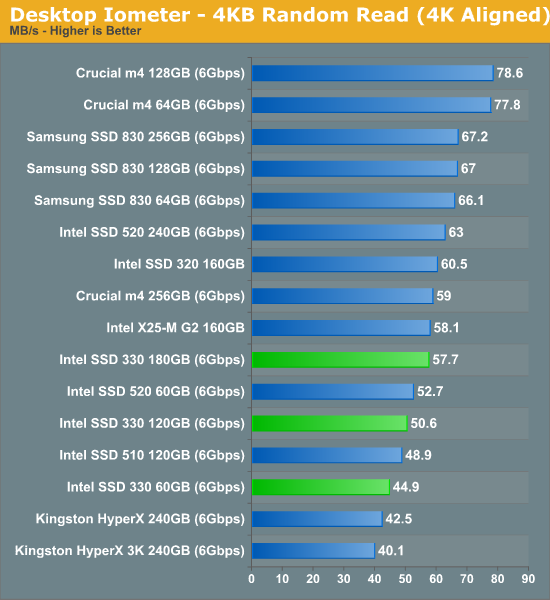
At similar capacities, the 330 and 520 offer nearly identical random read performance. The old X25-M G2 actually offers better random read performance than many of the newer drives, although most users would be hard pressed to tell the difference in actual usage.
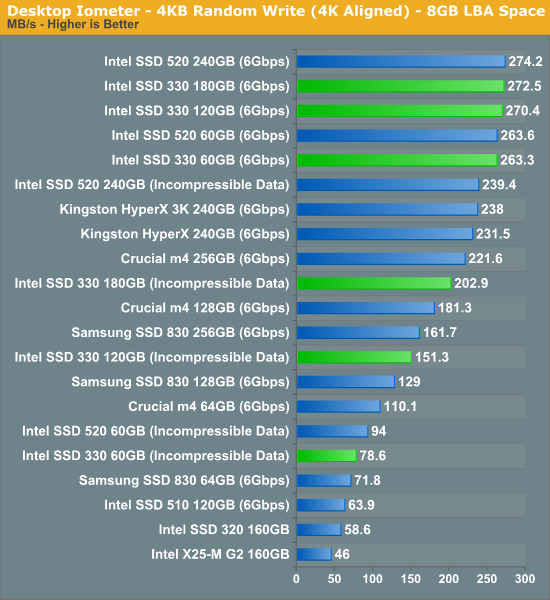
Random write performance is great with easily compressible data, but even when faced with data that can't be reduced the Intel SSD 330 does very well. Once again performance is very similar between the 330 and 520 drives.
Many of you have asked for random write performance at higher queue depths. What I have below is our 4KB random write test performed at a queue depth of 32 instead of 3. While the vast majority of desktop usage models experience queue depths of 0 - 5, higher depths are possible in heavy I/O (and multi-user) workloads:
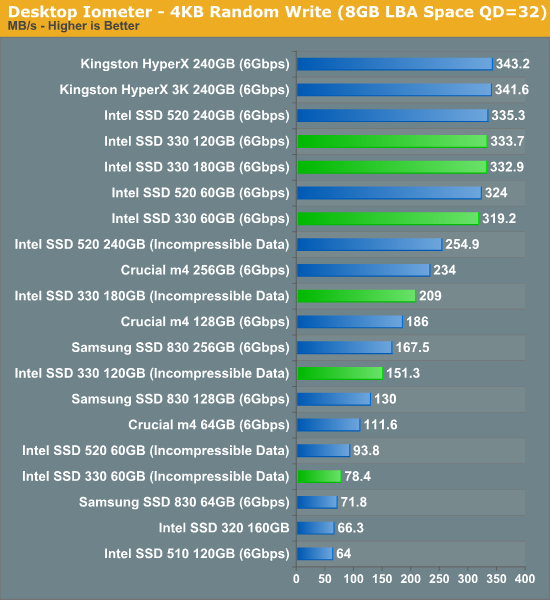
Sequential Read/Write Speed
To measure sequential performance I ran a 1 minute long 128KB sequential test over the entire span of the drive at a queue depth of 1. The results reported are in average MB/s over the entire test length.
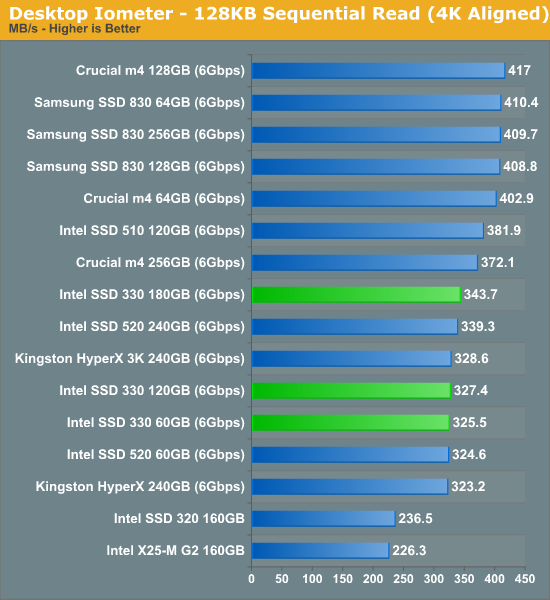
Low queue depth sequential read performance is good but not exactly class leading. Once again there's no real performance difference between the 330 and 520.
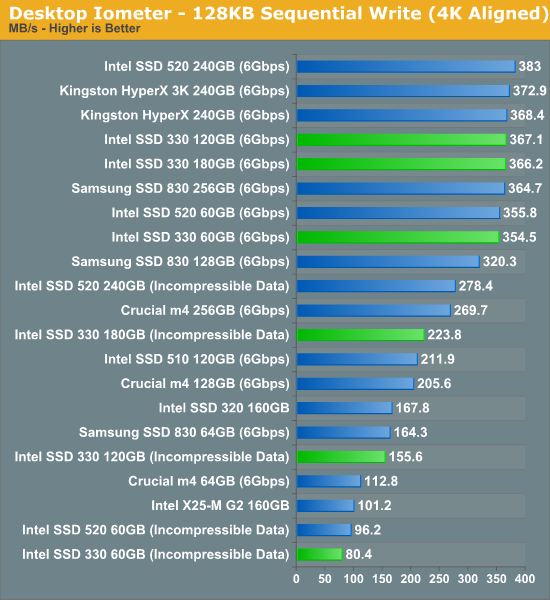
Sequential write performance with incompressible data is the biggest downside to any SandForce based drive. Try copying a compressed video or photos to the drive and you'll get speeds south of 230MB/s. The 60GB drive can only manage 80MB/s with incompressible data, that's actually no faster than the old Intel X25-M.
AS-SSD Incompressible Sequential Performance
The AS-SSD sequential benchmark uses incompressible data for all of its transfers. The result is a pretty big reduction in sequential write speed on SandForce based controllers.

Here we see what higher queue depth sequential reads look like. The 330 gets close to 500MB/s but never actually exceeds it.
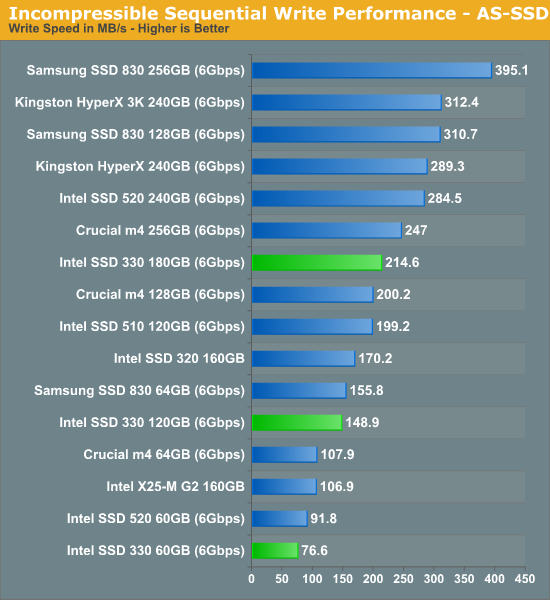
Incompressible sequential write performance, again, doesn't look very good.










64 Comments
View All Comments
Lacrimosa - Saturday, September 15, 2012 - link
Hello,Good review. I had been looking for Intel 330 for my laptop. I would like to have the data encrypted though and according to this review the 330 is not a good option for me then. What are the good comparable options then? Reliability and ability to encrypt are the qualities I would be looking for and it would be nice if the price weren't too high either.
P_Turner - Monday, December 3, 2012 - link
I've just RMA'd an Intel 330 SSD 180 GB back to Newegg. I get a BSOD on each and every resume from sleep. Unfortunately, Newegg won't issue refunds for this SSD (a Cyber Monday special), although they will process an RMA if you pay for the shipping.Be sure to read the Intel SSD forum BEFORE the purchase. Lots of complaints over BSODs on the 330 and 520. Worse, the complaints are just ignored by Intel.
Just my opinion, but all Sandforce based SSDs are obsolete from the get go. It's also my opinion that a big name on the label means nothing if the company just blows off customer issues.
P_Turner - Sunday, December 30, 2012 - link
The new Intel 330 180 GB that Newegg sent me was the same as the one I RMA'd. Same BSOD issue, 100% repeatable. So the question at this point was: is my Asus x83-vb laptop incompatible with SSDs?To answer the question, I pulled my 64 GB Crucial M4 out of my desktop, where it is the OS and program disk. Of course, I imaged the M4 first. The M4 then went into my Asus x83-vb after a secure erase.
The result was that the Crucial M4 was flawless. Newegg has relented and is allowing me to return the Intel 330 for store credit in the form of an e-gift card.
I've ordered a 256 gb M4 from Newegg, and I will post the results -- good or bad -- provided that posts to this article remain open. It could be that the Asus's BIOS doesn't allow an SSD larger than 64 GB or it could be that I just got lucky with my old M4. I'll know in two weeks.
ghabhaducha - Saturday, January 5, 2013 - link
Hi Anand,Thanks for such an awesome review of drives, clearly you have a talent for journalism.
After reading the extensive information you have on SSDs at Anandtech, I decided to purchase 2x Intel 330 240GB for the purposes of RAID0. Now, the way I understood it, the 180GB model uses 12x "29f16b08ccme2" Intel 16GB 25nm NAND flash, which based on your reviews, is also used by the OCZ Vertex 3 240GB and Kingston HyperX 240GB. I was curious if the Intel 330 240GB used the same "29f16b08ccme2" flash OR does it use the "29f16b08ccme3" flash that is used in the Kingston HyperX 3k? I really didn't want pry open my SSDs and void the warranty, but I was curious if you had documented this during your reviews.
Thanks,
ghabhaducha